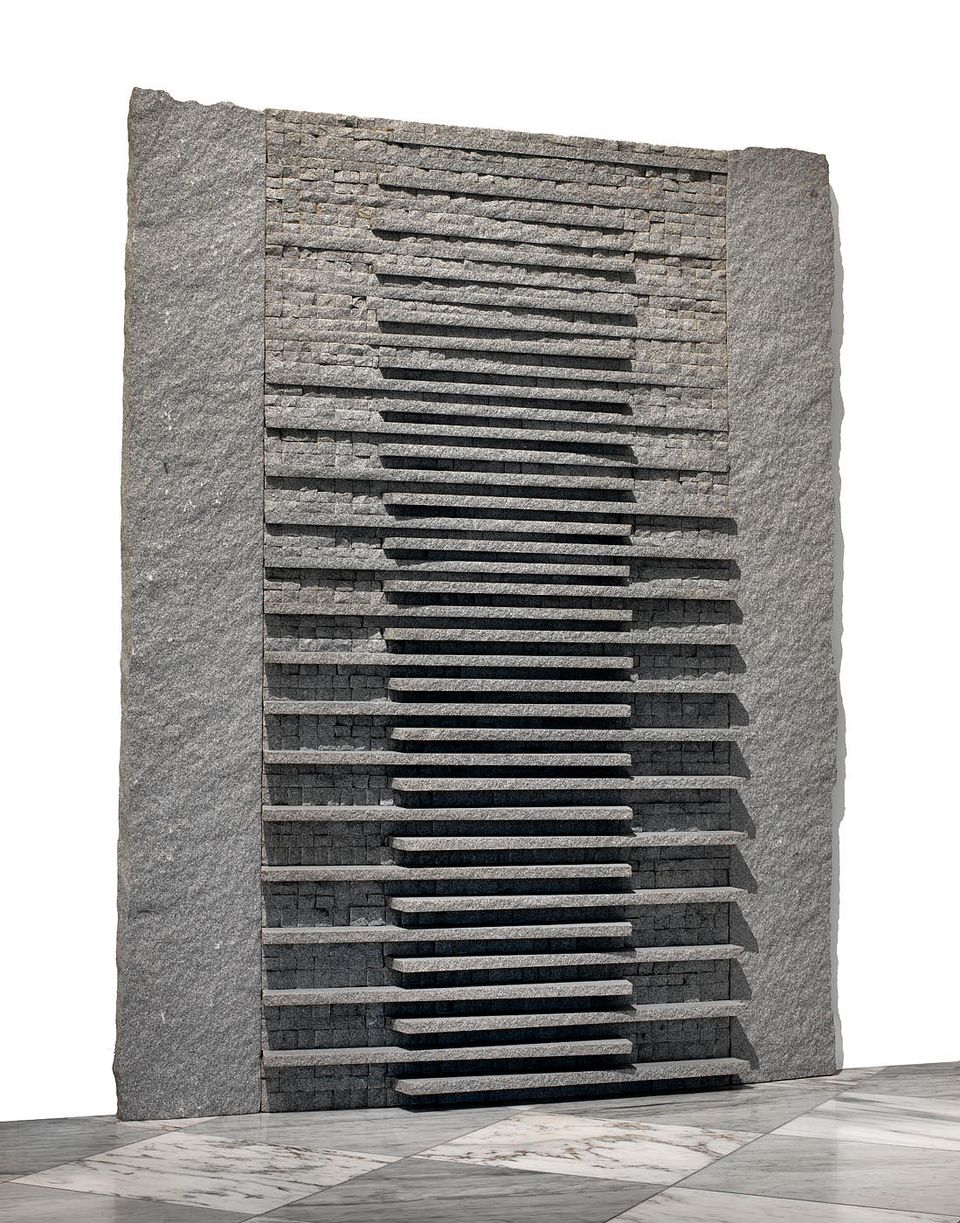
Jesús Moroles, Granite Weaving, 1988, Georgia gray granite, Smithsonian American Art Museum
About this Artwork
Moroles’s granite sculptures originate deep in the earth, born of fire and the volcanic action that created the very crust of the planet. Moroles began “weaving” granite in the late 1980s. Although he speaks in terms of fabric, Granite Weaving also reads as the wall of a stepped pyramid in which horizontal stone slabs support, and in turn are buttressed by, small blocks of granite. This sculpture unites minimalist forms and the natural materials of land art to recall ancient structures found in Indonesia, Mesopotamia (present-day Iraq), and Mexico.
Video
- Chapters
- descriptions off, selected
- captions and subtitles off, selected
This is a modal window.
In this series, E. Carmen Ramos, curator of Latino art, discusses the exhibition Our America: The Latino Presence in American Art at the Smithsonian American Art Museum. This episode looks at the sculpture Granite Weaving by Jesús Moroles. Our America: The Latino Presence in American Art presents the rich and varied contributions of Latino artists in the United States since the mid-twentieth century, when the concept of a collective Latino identity began to emerge. The exhibition is drawn entirely from the Smithsonian American Art Museum's pioneering collection of Latino art. It explores how Latino artists shaped the artistic movements of their day and recalibrated key themes in American art and culture.
He often works in two modes; he often works with a saw to cut granite, but at other times he leaves the material in its natural state. You see a combination of these two different types of textures throughout the sculpture. The sculpture itself, sort of resembles a weaving in a way, because of its verticality and its horizontal registers, but it also gives the impression of a pyramid, of a stepped pyramid. Morales forms part of a larger generation of Mexican-American and Chicano artists that were interested in Native-American culture.
This work, which evokes ancient architecture from Mexico, participates in a larger history of Chicano Indigenism, but Moroles will tell you that his work is very international. He’s traveled throughout the world, and he was very much influenced by the ancient art that he experienced in these other countries. His work blends references to various world cultures. It represents the different ways in which Latino artists have inflected movements of American art. In this case, he’s interested in exploring how the Earth itself can allude to ancient history.
Meet the Artist
- Chapters
- descriptions off, selected
- captions and subtitles off, selected
This is a modal window.
An interview with the artist Jesús Moroles. As a college student in North Texas, Jesús Moroles tried to carve granite with a hammer and chisel. After only thirty minutes, he recalls, "The stone took me over. It was so hard it barely showed what I had done to it . . . It controlled me. I fell in love with it." He began sculpting exclusively in granite, using a diamond-edged electrical saw capable of "tearing" the stone. Moroles went on to establish one of the largest stone-carving workshops in the country, which he runs with the help of his father, brother, and sister. In 2001, Moroles began to strike his sculptures, sometimes with batons, sometimes with his hands or his feet, creating a type of music one audience member called "an unearthly composition . . . that recalled the effect of the . . . Orient" (Adlmann, Moroles, 2003).
My tools are the same tools that I started with. I’m still trying to figure out what I can do with a chisel and hammer. As soon as you've touch stone with a chisel or anything you’ve actually killed the quartz in it, and it doesn’t reflect light anymore. So we actually tear it, just like when you tear paper it shows the fiber and that’s what we’re doing, we’re tearing it to show the inside the stone and all the facets that reflect light.
Yeah, this is where I saw this side.
JM: While I go to the quarry and I bring back some of the granite that somehow strikes me because of the size the shape, the texture the color of a vein in it. It may sit here for three or four years, and I’ll walked by and I’ll see something different in it and that will be the beginning step.
A stele means monolithic stone with writing on it. The “Georgia Stele,” I brought it to the museum uncarved, and I had each one of the staff members actually carve a piece out and then from that I started creating the piece. I often like participation in my work.
The museum has one of my earliest pieces, “Lapstrake,” and it’s the lapping of the earth. It’s like the stratus of the earth the layers and you know how they lap over so it’s stronger, and I thought it was a great name for it. But for me, when I looked at this stone there was a white vein been running through the granite, which is very unusual for granite. Granite is mainly made up of spots, and this had a white vein, so when I looked at the piece, I decided to carve everything away from that vein so that white veins stood out.
Actually, the pieces that I tore out of “Lapstrake” became another lapstrake because they tore out so beautifully. I go from working with a solid stone and creating a piece to creating pieces from the pieces that came off of that. My feeling is that I don’t think that I’m a gifted person. I think that I’m a very hard worker and that through hard work you can do what you want. You can do anything that you want.













